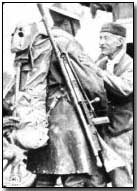Encyclopedia - Chauchat Gun
 The Chauchat comprised France's primary light
machine
gun throughout the First World War, although many regard it instead as
an automatic rifle.
The Chauchat comprised France's primary light
machine
gun throughout the First World War, although many regard it instead as
an automatic rifle.
Developed in 1907 (and revised in 1915) the Chauchat weighed around 10kg; its lightness ensured that it was the French infantry's predominant close-support weapon. It is estimated that 250,000 8mm Chauchats were produced during the war using revolutionary new metal stamping techniques - making it the most widely manufactured automatic weapon of the war - and that 50,000 remained in operation within the French Army at the end of the war.
The Chauchat was also adopted by other Allied armies in spite of a somewhat poor reputation; in trench conditions it was regarded as unreliable, with dirt entering via the magazine. The weapon's most common malfunction manifested itself in a failure to extract spent shells.
Somewhat unusually the Chauchat operated on a long recoil principle in which the entire barrel recoiled against a spring when fired. During its recoil the barrel was unlocked from the bolt which continued to recoil. At this point the spent shell was ejected with the barrel returning to its starting position. Given such a violent recoil the weapon proved problematic to fire in anything other than highly trained hands.
The American Expeditionary Force, awaiting delivery of their intended primary weapon, the Browning M1917 machine gun, intended to adopt the Chauchat as an interim measure, purchasing 34,000 in 1917. In order to make the transition to the Browning easier the Chauchat was modified to use 0.30 inch ammunition. However the French manufacturers used incorrect chamber measurements with the result that the weapons performed poorly.
In the event the AEF largely used French, i.e. unmodified, versions of the Chauchat rather than the U.S. model until the Browning became available.
A 'Tracer' was a phosphorescent machine-gun bullet which glowed in flight, indicating course as an aid to artillery.
- Did you know?
